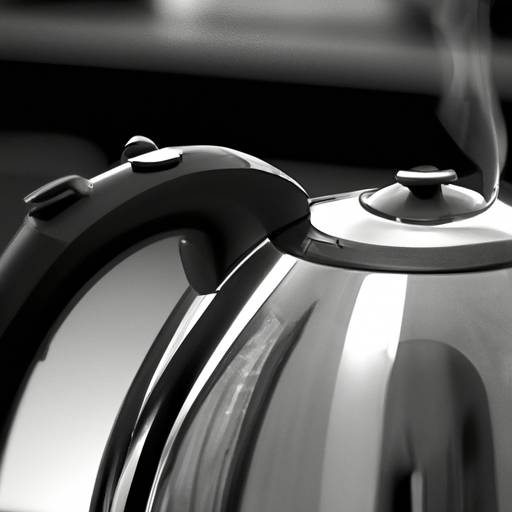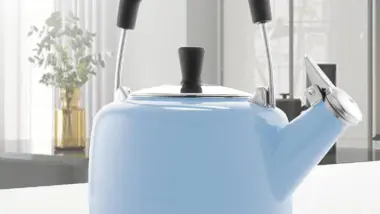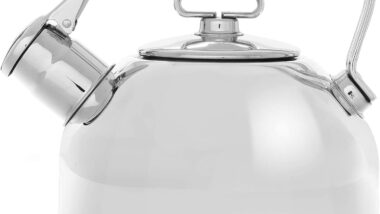Eliminate the New Kettle Taste
Have you ever experienced that unpleasant taste when using a brand-new kettle? It can be quite off-putting and ruin the enjoyment of your morning cup of tea or coffee. But fret not, because we have some excellent tips to help you eliminate that new kettle taste.
Nobody wants to start their day with a bitter or metallic flavor, so follow these easy solutions to ensure your hot beverages taste as they should – delicious! So, say goodbye to that unwanted taste and say hello to a perfect cuppa every time.
Understanding the New Kettle Taste
What is the new kettle taste?
When you first purchase a new kettle, you may notice a peculiar taste or smell. This is commonly referred to as the “new kettle taste.” It is characterized by a slightly metallic or plastic-like flavor in the water boiled in the kettle. While this taste can be off-putting, it is completely harmless and temporary.
Why does the new kettle taste occur?
The new kettle taste occurs due to the materials used in manufacturing the kettle. Most kettles are made from stainless steel, glass, or plastic, all of which can release slight residues, odors, or flavors when exposed to high temperatures for the first few uses. Additionally, some kettles may have protective coatings or chemicals from the manufacturing process that contribute to the taste.
How long does the new kettle taste last?
The duration of the new kettle taste can vary depending on several factors, including the kettle’s materials and construction. In general, the taste will diminish over time with regular use. On average, the new kettle taste should disappear after boiling water multiple times or after a few weeks of regular usage. However, there are several methods you can use to speed up the process and eliminate the taste more quickly.
Pre-cleaning the Kettle
Why is pre-cleaning important?
Before using your new kettle for the first time, it is essential to pre-clean it. Pre-cleaning helps remove any manufacturing residues, chemicals, or coatings that may contribute to the new kettle taste. Additionally, it ensures the kettle is clean and ready for use, providing a better overall experience and reducing the time needed for the taste to dissipate naturally.
The steps to pre-clean a new kettle
To pre-clean your new kettle, follow these simple steps:
- Begin by filling the kettle with water until it reaches its maximum capacity.
- Bring the water to a boil and allow it to boil for approximately 15 minutes.
- Once the water has boiled, discard it, and rinse the kettle thoroughly with clean water.
- Repeat this process once or twice to ensure any residues or flavors have been removed.
Using vinegar for pre-cleaning
Another effective method for pre-cleaning your new kettle is by using vinegar. Vinegar’s acidity helps break down residues and remove any lingering tastes or odors. To use vinegar for pre-cleaning, follow these steps:
- Mix equal parts vinegar and water, enough to fill your kettle.
- Fill the kettle with the vinegar-water solution and let it sit for about an hour.
- After an hour, discard the solution and rinse the kettle thoroughly.
- Boil fresh water in the kettle to remove any remaining vinegar smell.
Boiling Water Multiple Times
The benefits of boiling water multiple times
Boiling water multiple times is an effective method for eliminating the new kettle taste. This process helps remove any remaining residues, odors, or flavors by continuously exposing the kettle to high temperatures. The repeated boiling allows the kettle to undergo thorough cleaning, gradually reducing the new kettle taste.
The process of boiling water multiple times
To use this method, follow these steps:
- Fill the kettle with water to its maximum capacity.
- Bring the water to a boil and let it boil for a few minutes.
- Discard the boiled water and repeat the process.
- Repeat this process several times until the new kettle taste diminishes significantly or disappears completely.
It is important to note that you should discard the boiled water each time to ensure any residues or flavors are removed entirely.
Using Lemon Juice
Why lemon juice is effective against new kettle taste
Lemon juice is a natural and effective remedy for eliminating the new kettle taste. The acidity of lemon juice helps neutralize any residues, flavors, or odors in the kettle, leaving it fresh and ready for use. Lemon juice also adds a light and refreshing aroma to the boiled water, enhancing your overall tea or coffee experience.
How to use lemon juice to eliminate new kettle taste
Here’s a simple method for using lemon juice to eliminate the new kettle taste:
- Squeeze the juice of one or two lemons, depending on the size, into a cup or bowl.
- Dilute the lemon juice with an equal amount of water.
- Pour the lemon juice mixture into the kettle.
- Fill the kettle with water to its maximum capacity.
- Bring the water to a boil and let it boil for a few minutes.
- Discard the water and rinse the kettle thoroughly.
By following these steps, you can enjoy fresh-tasting water from your kettle without any traces of the new kettle taste.
Alternative citrus options
If you don’t have lemons on hand, you can also use other citrus fruits like limes or oranges. The acidic properties of these fruits will help eliminate the new kettle taste in a similar manner to lemon juice. Simply follow the same steps mentioned above, substituting the citrus juice accordingly.
Baking Soda Solution
Why baking soda is a popular option
Baking soda is a well-known household ingredient with various cleaning properties. It is an effective option for eliminating the new kettle taste due to its ability to neutralize odors, remove residues, and provide a thorough cleaning. Baking soda is also non-toxic and safe to use, making it an ideal choice for cleaning kitchen appliances like kettles.
Creating a baking soda solution
To create a baking soda solution for cleaning your kettle, follow these steps:
- Mix two tablespoons of baking soda with water in a cup or bowl until it forms a paste.
- Apply the baking soda paste to the inside of the kettle, focusing on any areas with visible residues or stains.
- Let the paste sit for about 15-30 minutes to allow it to work its magic.
- Use a sponge or soft brush to scrub the interior of the kettle gently.
- Rinse the kettle thoroughly with clean water, ensuring all traces of the baking soda and residues have been removed.
Cleaning the kettle with baking soda
After creating the baking soda solution, you can also use it to clean the exterior of your kettle. Apply the baking soda paste to a damp cloth and gently scrub the surface, removing any dirt or stains. Rinse the exterior with clean water and wipe it dry for a sparkling clean kettle.
Activated Charcoal Method
The role of activated charcoal in removing new kettle taste
Activated charcoal is highly porous and can absorb impurities, chemicals, and unpleasant tastes or odors. It is an excellent natural solution for eliminating the new kettle taste. By using activated charcoal in your kettle, you can effectively filter out any residual flavors or odors, ensuring your boiled water is clean, fresh, and free from the new kettle taste.
Creating an activated charcoal filter
To create an activated charcoal filter for your kettle, follow these steps:
- Purchase food-grade activated charcoal from a reputable supplier.
- Rinse the charcoal thoroughly under running water to remove any dust or particles.
- Place the activated charcoal in a clean, breathable cloth or filter bag. Make sure the cloth or bag is large enough to contain the charcoal securely.
- Tie or seal the cloth or bag, ensuring the charcoal is enclosed.
- Place the activated charcoal filter in the kettle, ensuring it is fully submerged in the water during the boiling process.
- Boil the water as usual, allowing the activated charcoal to neutralize any residual tastes or odors.
Using an activated charcoal filter in the kettle
When using an activated charcoal filter in your kettle, it is important to monitor and replace the charcoal regularly. Depending on the usage and the extent of the new kettle taste, the charcoal may need replacing every few weeks or months. Regularly rinsing and inspecting the charcoal will ensure optimal effectiveness in eliminating the new kettle taste.
Boiling Tea Leaves
How tea leaves help in eliminating new kettle taste
Tea leaves are known for their ability to add flavor and aroma to water. Boiling tea leaves in your kettle can effectively mask the new kettle taste, infusing the water with pleasant flavors and reducing any residual odors or flavors. This method not only eliminates the new kettle taste but also allows you to enjoy a cup of tea brewed with the flavors you love.
The process of boiling tea leaves
To use tea leaves for eliminating the new kettle taste, follow these steps:
- Choose your preferred type of tea leaves. Black tea, green tea, or herbal teas work well for this purpose.
- Place the desired amount of tea leaves in a tea infuser or directly into the kettle.
- Fill the kettle with water, ensuring the tea leaves are fully submerged.
- Bring the water to a boil and let it simmer for a few minutes to allow the flavors to infuse.
- Discard the water and tea leaves.
- Rinse the kettle thoroughly to remove any residual flavors or tea stains.
Following these steps will result in water that is free from the new kettle taste and infused with the delightful flavors of your chosen tea.
Types of tea leaves to use
When using tea leaves to eliminate the new kettle taste, you have various options to choose from. Each type of tea imparts its own unique flavors and aromas. Here are a few popular choices:
- Black tea: Known for its strong and bold flavors, black tea can help mask the new kettle taste effectively.
- Green tea: This lighter tea variety offers a refreshing taste and can provide a pleasant change to the water boiled in your kettle.
- Herbal tea: Herbal infusions like chamomile, peppermint, or fruit blends can add a touch of natural sweetness to the boiled water, eliminating any unwanted tastes.
Feel free to explore different tea flavors and find the one that suits your palate best.
Using Citric Acid
The effectiveness of citric acid in removing new kettle taste
Citric acid is a powerful natural acid derived from citrus fruits. It is known for its cleaning and descaling properties. When used in a solution, citric acid can effectively remove residues, limescale, and the new kettle taste. It provides a thorough cleaning and leaves your kettle fresh, odor-free, and ready for use.
Creating a citric acid solution
To create a citric acid solution for cleaning your kettle, follow these steps:
- Dissolve one or two tablespoons of food-grade citric acid in a cup of warm water. Adjust the ratio depending on the size of your kettle.
- Pour the citric acid solution into the kettle.
- Fill the kettle with water until it reaches its maximum capacity.
- Bring the water to a boil and let it boil for a few minutes.
- Discard the water and rinse the kettle thoroughly.
By using this citric acid solution, you can effectively eliminate the new kettle taste and remove any limescale or residues that may have accumulated.
Cleaning the kettle with citric acid
Apart from using the citric acid solution, you can also directly apply citric acid powder to the interior of your kettle for a deep clean. Mix a small amount of citric acid powder with water to form a paste, and then apply the paste to the areas with stains or residues. Leave it on for a few minutes before scrubbing gently and rinsing thoroughly. This method provides a more intensive cleaning and can help remove stubborn residues that contribute to the new kettle taste.
Allowing Natural Dissipation
How time can eliminate the new kettle taste
Patience is key when it comes to allowing the new kettle taste to dissipate naturally. Over time, the repeated use of the kettle and exposure to heat will gradually lessen the taste until it disappears completely. Allowing natural dissipation is a hands-off approach that requires no additional steps or remedies.
The best practice for natural dissipation
To facilitate the natural dissipation of the new kettle taste, it is important to use your kettle regularly for boiling water. The constant exposure to high temperatures will help expedite the process. Additionally, be sure to discard the water after boiling, as this will prevent any residual tastes or odors from affecting subsequent batches of boiled water.
Factors that affect natural dissipation
Several factors can influence the duration of the new kettle taste and the rate of natural dissipation. The materials used in the kettle’s construction, the presence of any coatings or chemicals, and the frequency of use all play a role. In general, regularly using the kettle and following recommended cleaning methods can contribute to faster natural dissipation.
Regular Cleaning and Maintenance
The importance of regular cleaning
Regular cleaning is essential to maintain the quality and performance of your kettle. It not only helps eliminate the new kettle taste but also prevents the buildup of limescale or residues that can affect the taste and functionality of the kettle. By incorporating regular cleaning into your routine, you can ensure that your kettle remains in optimal condition for years to come.
Recommended cleaning methods for a clean kettle
To keep your kettle clean and free from the new kettle taste, follow these recommended cleaning methods:
- Regularly rinse the kettle with warm water after each use to remove any residual flavors or odors.
- Clean the exterior of the kettle using a mild dish soap or a vinegar-water solution to remove any stains or dirt.
- For a deeper clean, use the pre-cleaning methods mentioned earlier, such as vinegar or baking soda solutions, to eliminate any stubborn residues or limescale.
Maintenance tips to prevent new kettle taste
Alongside regular cleaning, incorporating a few maintenance tips can help prevent the new kettle taste from occurring or recurring:
- Avoid overfilling the kettle beyond its maximum capacity, as this can lead to spills or residue buildup.
- Use filtered or distilled water when possible to reduce the chances of mineral deposits causing unwanted tastes.
- Empty and dry the kettle thoroughly before storing it to prevent the growth of bacteria or mold.
By following these maintenance tips and integrating regular cleaning into your kettle routine, you can ensure a clean and pleasant taste in every cup of water boiled in your kettle.
Eliminating the new kettle taste requires a combination of cleaning techniques, patience, and regular use. Whether you choose to pre-clean the kettle, boil water multiple times, use natural remedies like lemon juice or activated charcoal, or allow for natural dissipation, remember that the taste is temporary and will improve over time. With the tips provided, you can confidently bid farewell to the new kettle taste and enjoy the pure, refreshing flavor of your favorite hot beverages. Happy boiling!





